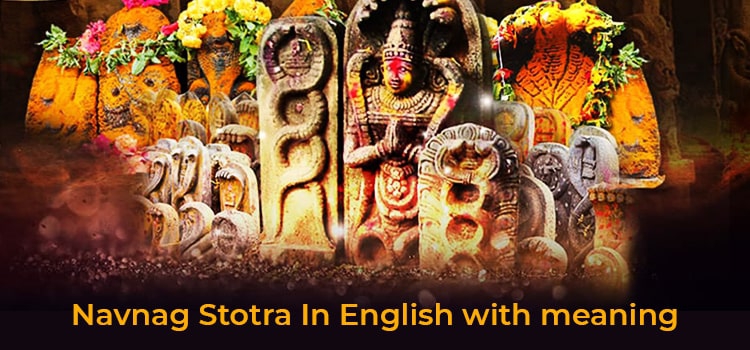Navnag Stotra : Powerful Mantra Of The Nine Nagas
Navnag Stotra is dedicated to the 9 Naga Devtas (Snake Gods) - Ananta, Vasuki, Shesha, Padmanabh, Kambal, Shankhapal, Dhrutrashtra, Takshaka, and Kalia.
Who are the Nagas?
The Nagas, or serpent clan, comprised the sons of Sage Kashyap and his wife, Kadru. The Mahabharata epic begins with the story of the Naga race.
The Naga race, which flourished in northwest India, was almost completely destroyed by King Janamejaya, who was a Kuru king from Arjuna's lineage. It was he who massacred the Nagas at Takshasila. But Sage Astika, a Brahmin who was the son of Manasa (the sister of all Nagas) and Sage Jaratkaru, stopped the massacre. The reason for the enmity between the Nagas and the Kuru kings stemmed from the actions of the Pandava prince, Arjuna, and the Naga called Takshaka.

Arjuna killed the wife of Takshaka, the king of the Nagas, who lived in the Khandava Forest. Takshaka, in league with Shringhi, killed the grandson of Arjuna, Parikshit, by poisoning him. Following this, King Janamejaya embarked on a Sarpa Satra or snake sacrifice to massacre all snakes in order to avenge his father Parikshit's death. But Sage Astika convinced the king to halt the sacrifice on Shukla Paksha Panchami in the Hindu month of Shravan. Since then, Hindus have celebrated this day as Naga Panchami festival, when people worship the Snake Gods or Naga Devtas.
In Vedic astrology, Rahu and Ketu are identified with snakes, the head and tail, respectively. When all the other planets in a horoscope are hemmed in between Rahu and Ketu, it results in the dreaded Kaala Sarpa Dosha, which causes many problems in life. Doing Poojas for Naga Devtas and worshipping snakes on Naga Panchami and Naga Chaturthi are remedies for this Dosha.
The Nava Nagas (Nine Nagas)
The 9 Naag Devatas are Ananta, Vasuki, Shesha, Padmanabh, Kambal, Shankhapal, Dhrutrashtra, Takshaka, and Kalia. The Nav Naga Stotram is a powerful Mantra dedicated to these 9 Nagas. People chant it on Nag Panchami, Naga Chaturthi, and Shasti days. The Ramayana, Mahabharata, and other religious texts like the Puranas have many references to the Nagas.
Let us learn more about the most prominent Naga Devtas.
Adishesha
Adishesha/ Sheshanaga is the king of the Nagas. As per the Puranas, he holds all the planets and the universe on his hoods and sings the glories of Lord Vishnu, who is often depicted as resting on Shesha.
Supposedly, Shesha supports Kurma (the giant tortoise). When Kurma moved, Shesha yawned, and this supposedly caused earthquakes. Shesha in Sanskrit means ‘remainder’. When the entire world is destroyed at the end of Kalpa, Shesha alone remains as he is. Shesha was the eldest of Kashayapa’s sons.
Vasuki
The snake lying coiled around Lord Shiva’s neck is Vasuki. Shiva supposedly blessed Vasuki and wore him like an ornament. He is the king of Nagas and carries a precious gem called Nagamani on his head. Both the Ramayana and Mahabharata mention him. Vasuki acted as the churning rope during ‘Samudra Manthan’.
Kaliya
Kaliya was a poisonous snake who lived in the Yamuna river in Vrindavan. The water boiled and bubbled due to his poison for 4 leagues, and no humans, animals, or birds could go anywhere near the river. Kaliya used to live on Ramanaka Dwipa but shifted to Vrindavan as he was afraid of Garuda, the enemy of serpents. A yogi had cursed Garuda that he could not enter Vrindavan.
Once, Lord Krishna and his friends were playing on the banks of the river. The ball fell into the river. When Krishna jumped into the river to retrieve the ball, Kaliya rose up with his 110 hoods vomiting poison. After a fight, Krishna emerged from the bottom of the river, dancing on Kaliya’s head. This is called ‘Kaliya Nartana’.
Takshaka
A Naga king, he was also the friend of Lord Indra. He belonged to the Ikshvaku dynasty and was Lord Rama’s descendant. Takshaka resided in the Khandav forest, where the Nagas lived along with other tribes like the Pisachas, Rakshasas, Daityas, and Danavas (Asura clans).
Arjuna burned the forest at Agni’s behest. Takshaka was not there at the time. But Aswasena, his son, was there. Arjuna killed Takshaka's wife and the mother of Aswasena. Aswasena escaped, and to avenge his mother’s death, he attacked Arjuna during the Kurukshetra War while he was fighting Karna.
Navnag Stotra
Anantam Vasukim Shesham
Padmanabham cha Kambalam
Shankhapalam Dhartarashtram
Taxakam Kaliyam Tatha
Etani Nava Navaami Naganancha Mahatmana
Sayam Patenityam Prathahkaale Visheshita
Tasya Vishabhayam Naasti Sarvatra Vijayaa Bhaveth
Navnag Stotra Meaning
Ananta, Vasuki, Shesha, Padmanabha, Kambal, Shankhapal, Dhritarashtra, Takshaka, and Kaliya are the nine major names of the snake deity. Whoever recites this in the evening, but especially in the morning, his fear will be destroyed, and he will be victorious.
Benefits of Navnag Stotra
People also chant the Navnag Stotra to avoid all kinds of negative effects, curses, and black magic. It can also remove Naga Dosha, Kala Sarpa Dosha, Rahu Dosha, and Ketu Dosha. Pregnant ladies chant this Mantra for a safe delivery and the well-being of the fetus in the womb.
Poornima, Tuesdays, Nag Panchami, any Panchami thithis, or Amavasya days are ideal for chanting this Stotra. If one chants it 11, 21, 108, or 1008 times, one can get all kinds of spiritual powers. Recite the Stotra facing the east direction. One can also worship Goddess Nageswari with neem leaves.



















